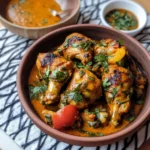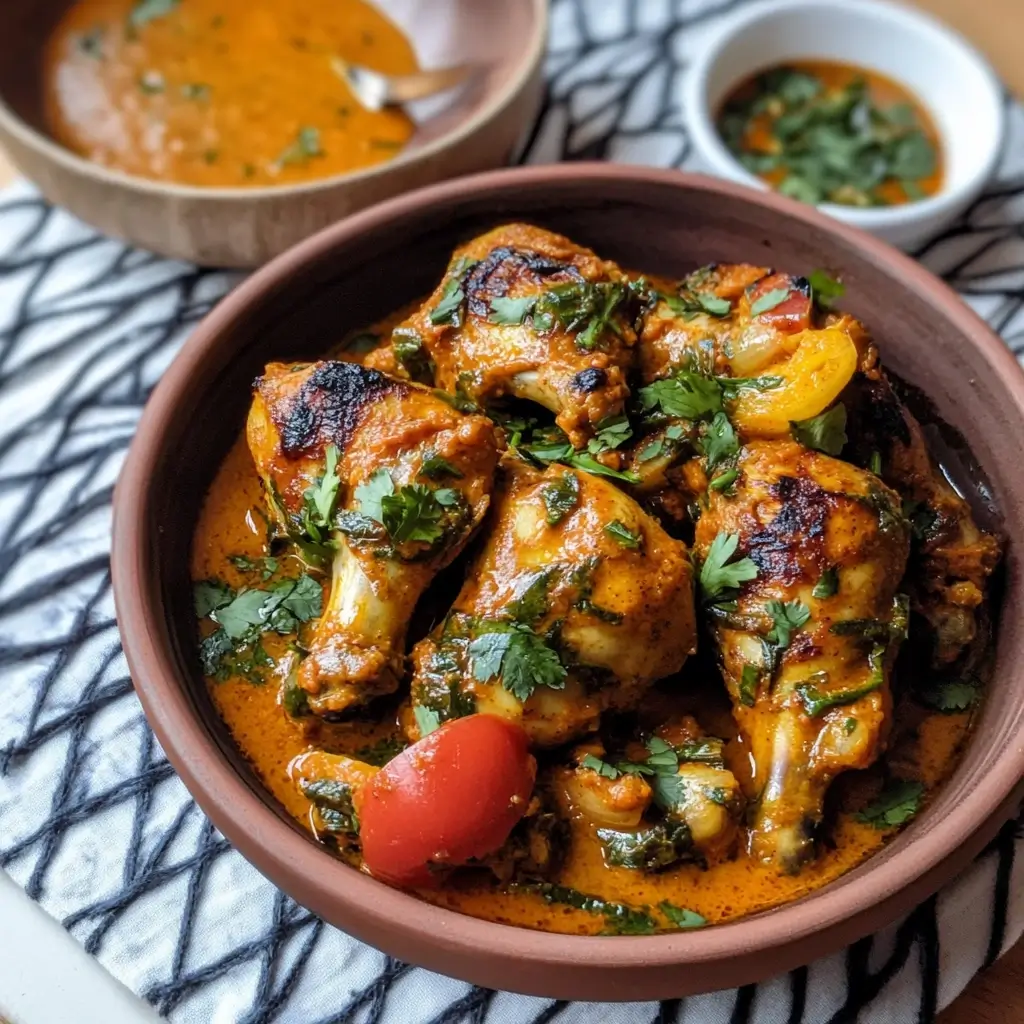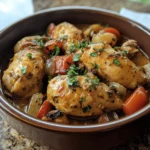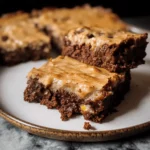The aroma alone transports you. A symphony of warm spices, fragrant coconut milk, and the savory scent of chicken simmering to perfection – that’s Kuku Paka. From the moment I first encountered this East African culinary gem, it was love at first bite. My family, usually a tough crowd when it comes to trying new dishes, was instantly captivated. The creamy, rich sauce clinging to tender chicken pieces, the gentle heat from the chilies, and the subtle sweetness of coconut created a flavor profile that was both comforting and exciting. Since then, Kuku Paka has become a regular feature on our dinner table, a dish that evokes warmth, togetherness, and the vibrant spirit of East African cuisine. It’s surprisingly easy to make, yet delivers a depth of flavor that rivals restaurant-quality curries. If you’re looking to expand your culinary horizons and delight your taste buds, Kuku Paka is an absolute must-try. Prepare to be transported to the sun-kissed shores of East Africa with every delicious mouthful.
Ingredients: The Heart of Authentic Kuku Paka
Creating truly exceptional Kuku Paka starts with sourcing high-quality, fresh ingredients. Each element plays a vital role in building the complex and nuanced flavors that define this iconic dish. Here’s a detailed breakdown of what you’ll need to embark on your Kuku Paka culinary journey:
- Chicken: 1.5 kg, bone-in, skin-on chicken pieces (thighs and drumsticks recommended). For the most authentic and flavorful Kuku Paka, bone-in, skin-on chicken pieces are non-negotiable. The bones contribute depth of flavor as they simmer in the sauce, while the skin renders down, adding richness and moisture to the dish. Thighs and drumsticks are particularly well-suited as they remain tender and juicy even after prolonged cooking, unlike chicken breasts which can become dry. Feel free to use a whole chicken cut into pieces for a more traditional approach.
- Onions: 2 large, finely chopped. Onions form the aromatic base of many curries and stews, and Kuku Paka is no exception. Finely chopping them ensures they melt seamlessly into the sauce, releasing their sweet and savory notes. Yellow or brown onions work best, providing a robust flavor that stands up to the spices.
- Tomatoes: 4 large, ripe tomatoes, finely chopped or 1 (400g) can of diced tomatoes. Tomatoes bring acidity and sweetness to the Kuku Paka sauce, balancing the richness of the coconut milk and the warmth of the spices. Fresh, ripe tomatoes are ideal when in season, offering a vibrant flavor. In a pinch, good quality canned diced tomatoes are a perfectly acceptable substitute, ensuring consistency and convenience.
- Ginger: 2-inch piece, peeled and grated or finely minced. Ginger is a cornerstone of East African cuisine, adding a pungent, zesty warmth that elevates the overall flavor profile. Fresh ginger is crucial for its bright and aromatic qualities. Grating or mincing it finely allows its flavors to infuse the sauce effectively.
- Garlic: 4-5 cloves, minced. Garlic complements ginger beautifully, contributing a savory, slightly pungent note that enhances the depth of flavor. Freshly minced garlic is always preferred for its intense aroma and taste.
- Green Chilies: 2-3, finely chopped (adjust to your spice preference). Green chilies provide the essential heat in Kuku Paka, adding a vibrant kick that awakens the palate. The quantity can be adjusted to suit your spice tolerance. For a milder dish, use fewer chilies or remove the seeds and membranes. For a spicier version, you can increase the number or opt for hotter varieties.
- Coconut Milk: 400ml full-fat coconut milk. Full-fat coconut milk is the soul of Kuku Paka, lending its signature creamy texture and rich, sweet flavor. It creates the luxurious sauce that coats the chicken and makes this dish so incredibly satisfying. Using full-fat coconut milk is essential for achieving the desired richness and consistency. Light coconut milk will result in a thinner, less flavorful sauce.
- Vegetable Oil: 3-4 tablespoons. Vegetable oil is used for sautéing the aromatics and browning the chicken, creating a flavorful foundation for the dish. Any neutral-flavored oil like canola or sunflower oil will work well.
- Spices: A carefully curated blend of spices is what truly defines the character of Kuku Paka. Each spice contributes its unique aroma and flavor, creating a harmonious and complex profile.
- Cumin Seeds: 1 teaspoon. Cumin seeds offer a warm, earthy, and slightly bitter note that adds depth to the spice blend.
- Coriander Powder: 2 teaspoons. Coriander powder brings a citrusy, slightly sweet, and warm flavor that complements the other spices beautifully.
- Turmeric Powder: 1 teaspoon. Turmeric powder adds a warm, earthy, and slightly bitter flavor, along with its vibrant golden color. It also boasts anti-inflammatory properties.
- Garam Masala: 1 teaspoon. Garam masala is a blend of warm spices, typically including cinnamon, cardamom, cloves, and black pepper. It adds a fragrant and complex finishing touch to the dish. Use a good quality garam masala for the best flavor.
- Curry Powder: 1 tablespoon. Curry powder, while not traditionally East African, is often incorporated in Kuku Paka recipes and adds a layer of familiar curry flavor. Choose a mild or medium curry powder to avoid overpowering the other spices.
- Fresh Coriander Leaves: A small bunch, chopped, for garnishing. Fresh coriander leaves provide a bright, herbaceous, and slightly citrusy finish, adding freshness and visual appeal to the dish.
- Salt: To taste. Salt is essential for seasoning and enhancing the flavors of all the ingredients. Adjust the amount to your preference.
- Black Pepper: Freshly ground, to taste. Freshly ground black pepper adds a pungent, slightly spicy note that complements the other spices and enhances the overall flavor.
Instructions: Crafting Authentic Kuku Paka Step-by-Step
Making Kuku Paka at home is a rewarding culinary experience. Follow these detailed, step-by-step instructions to create a dish that’s bursting with authentic East African flavors:
Step 1: Marinate the Chicken (Optional but Recommended)
While not strictly essential, marinating the chicken enhances both its flavor and tenderness. For a richer, more flavorful Kuku Paka, consider this simple marinade:
- In a large bowl, combine the chicken pieces with 1 teaspoon of ginger paste (or finely grated ginger), 1 teaspoon of garlic paste (or minced garlic), ½ teaspoon of turmeric powder, ½ teaspoon of coriander powder, and a pinch of salt.
- Mix well to ensure the chicken is evenly coated with the marinade.
- Cover the bowl and refrigerate for at least 30 minutes, or preferably 1-2 hours for deeper flavor penetration. Overnight marination is also an option for maximum flavor infusion.
Step 2: Sauté the Aromatics – Building the Flavor Base
Creating a flavorful base is crucial for a delicious Kuku Paka. Sautéing the aromatics releases their essential oils and builds a foundation of flavor:
- Heat vegetable oil in a large, heavy-bottomed pot or Dutch oven over medium heat.
- Add cumin seeds and let them sizzle for about 30 seconds, until fragrant. This process, known as tempering, releases the aromatic oils of the cumin seeds.
- Add finely chopped onions and sauté until they turn golden brown and softened, approximately 8-10 minutes. Stir frequently to prevent burning and ensure even cooking. Patience is key here; well-caramelized onions contribute a depth of sweetness and flavor to the sauce.
- Add minced ginger and garlic to the pot and sauté for another 1-2 minutes, until fragrant. Be careful not to burn the garlic and ginger, as this can impart a bitter taste.
Step 3: Incorporate Tomatoes and Spices – Layering Flavors
Adding tomatoes and spices at this stage builds complexity and depth of flavor in the Kuku Paka sauce:
- Add finely chopped tomatoes (or canned diced tomatoes) to the pot. Cook until they soften and break down, forming a pulpy mixture, about 5-7 minutes. This process helps to create a richer, thicker sauce.
- Add green chilies, coriander powder, turmeric powder, curry powder, and garam masala to the pot.
- Sauté the spices for 1-2 minutes, stirring constantly, until fragrant. This process, known as blooming the spices, releases their aromas and enhances their flavors. Be cautious not to burn the spices; reduce the heat if necessary.
Step 4: Brown the Chicken (If Not Marinated) – Enhancing Savory Notes
If you skipped the marination step, browning the chicken now will add a layer of savory flavor to the dish:
- If you haven’t marinated the chicken, add the chicken pieces to the pot and brown them on all sides, about 5-7 minutes. Browning the chicken creates Maillard reaction, which adds depth and complexity to the flavor.
- If you marinated the chicken, you can skip this step or lightly brown the chicken for a few minutes for added texture and flavor.
Step 5: Simmer in Coconut Milk – Creating the Creamy Sauce
Coconut milk is the star ingredient that transforms the spiced base into a luscious, creamy sauce:
- Pour in the full-fat coconut milk into the pot.
- Add salt and freshly ground black pepper to taste.
- Bring the mixture to a simmer, then reduce the heat to low, cover the pot, and let it simmer gently for 30-40 minutes, or until the chicken is cooked through and tender. Simmering allows the flavors to meld together and the chicken to become incredibly tender. Check the chicken for doneness by piercing the thickest part with a fork; the juices should run clear.
- Stir occasionally to prevent the sauce from sticking to the bottom of the pot.
Step 6: Finish and Garnish – Adding Freshness and Aroma
The final touches elevate the Kuku Paka to perfection:
- Once the chicken is cooked through and the sauce has thickened to your desired consistency, remove from heat.
- Stir in half of the chopped fresh coriander leaves. This adds a burst of freshness and herbaceous aroma.
- Taste and adjust seasoning if needed, adding more salt or pepper to your preference.
Step 7: Serve and Enjoy!
Your homemade Kuku Paka is now ready to be served and enjoyed! Follow the serving suggestions below for a complete and satisfying meal.
Nutrition Facts (Estimated)
(Please note: Nutritional values are estimates and can vary based on specific ingredients used and serving sizes.)
Serving Size: Approximately 1.5 cups (350-400g)
Servings per recipe: 6-8 servings
Approximate Calories per serving: 450-550 calories
Estimated Nutritional Breakdown per serving (approximate):
- Protein: 35-45g
- Fat: 30-40g (Primarily from coconut milk and chicken skin, including saturated and unsaturated fats)
- Saturated Fat: 20-25g (Primarily from coconut milk and chicken skin)
- Carbohydrates: 10-15g
- Fiber: 2-3g
Important Considerations:
- These are estimates and can vary depending on the specific cuts of chicken used (e.g., using skinless chicken thighs will reduce fat content), the type of coconut milk, and portion sizes.
- Kuku Paka is a relatively calorie-dense dish due to the coconut milk and chicken skin.
- It’s a good source of protein and contains some carbohydrates and fiber from vegetables.
- For a healthier version, consider using skinless chicken pieces, reducing the amount of oil, and serving with brown rice or whole-wheat roti instead of white rice or naan.
Preparation Time: Plan Your Culinary Journey
Knowing the preparation and cooking times helps in planning your meal preparation effectively. Kuku Paka, while incredibly flavorful, is not overly time-consuming to make.
Prep Time: 20-25 minutes (including chopping vegetables and preparing marinade, if using)
Cook Time: 45-55 minutes (including sautéing, simmering, and cooking chicken)
Total Time: Approximately 1 hour 5 minutes – 1 hour 20 minutes
Breakdown:
- Ingredient Preparation (Chopping, Grating, Mincing): 15-20 minutes
- Marinating Chicken (Optional): 30 minutes to 2 hours (passive time)
- Sautéing Aromatics and Spices: 15-20 minutes
- Simmering Chicken in Coconut Milk: 30-35 minutes
Tips for Time Management:
- Prep Ahead: Chop onions, tomatoes, ginger, garlic, and chilies in advance and store them in the refrigerator. You can also pre-measure your spices.
- Marinate Chicken in Advance: Marinating the chicken the night before significantly reduces prep time on the day of cooking.
- Utilize Canned Tomatoes: Using canned diced tomatoes saves time compared to chopping fresh tomatoes.
- Multitask: While the onions are sautéing, you can prepare the spices and chop the coriander. While the chicken is simmering, you can prepare side dishes like rice or roti.
How to Serve Kuku Paka: Completing the East African Feast
Kuku Paka is a versatile dish that pairs beautifully with a variety of accompaniments. Here are some serving suggestions to create a complete and satisfying East African meal:
- Rice:
- Basmati Rice: Fragrant basmati rice is a classic pairing for Kuku Paka. Its light and fluffy texture complements the rich and creamy sauce perfectly.
- Plain White Rice: Simple steamed white rice is also a good option, allowing the flavors of the Kuku Paka to shine.
- Coconut Rice: For an extra layer of coconut flavor, serve Kuku Paka with coconut rice. This enhances the tropical notes of the dish.
- Pilau Rice: For a more flavorful rice option, consider serving with pilau rice, which is infused with spices like cardamom, cloves, and cinnamon.
- Bread:
- Naan Bread: Soft and fluffy naan bread is excellent for scooping up the delicious Kuku Paka sauce.
- Roti: Whole wheat roti, a traditional flatbread, is another great option for soaking up the flavors.
- Chapati: Similar to roti, chapati is a simple and versatile flatbread that complements Kuku Paka well.
- Vegetables and Sides:
- Sukuma Wiki (Collard Greens): A classic East African side dish of collard greens cooked with onions and tomatoes, Sukuma Wiki provides a healthy and flavorful counterpoint to the richness of Kuku Paka.
- Kachumbari (Tomato and Onion Salad): A refreshing and tangy salad of diced tomatoes, onions, and chilies, Kachumbari adds a crisp and vibrant element to the meal.
- Roasted Vegetables: Roasted vegetables like potatoes, carrots, or bell peppers can be served alongside Kuku Paka for a heartier meal.
- Green Salad: A simple green salad with a light vinaigrette provides a fresh and cleansing contrast to the rich curry.
- Garnishes:
- Fresh Coriander Leaves: Sprinkle freshly chopped coriander leaves over the Kuku Paka just before serving for a burst of fresh aroma and flavor.
- Lime Wedges: Serve lime wedges on the side for squeezing over the Kuku Paka, adding a touch of acidity and brightness.
- Sliced Red Onions: Thinly sliced red onions can be used as a garnish for a bit of sharpness and visual appeal.
- Yogurt or Raita: A dollop of plain yogurt or raita (yogurt with cucumber and spices) can help cool down the spice and add a creamy element.
Serving Presentation:
- Serve Kuku Paka hot, garnished with fresh coriander leaves, in a serving bowl.
- Arrange the rice or bread alongside the Kuku Paka.
- Offer side dishes and garnishes separately to allow diners to customize their plates.
- For a more authentic presentation, consider serving Kuku Paka in a traditional earthenware pot or serving dish.
Additional Tips for Perfect Kuku Paka
Elevate your Kuku Paka from good to exceptional with these helpful tips:
- Use Full-Fat Coconut Milk: For the creamiest and richest sauce, always opt for full-fat coconut milk. Light coconut milk will result in a thinner and less flavorful dish. The richness of full-fat coconut milk is essential for the authentic Kuku Paka experience.
- Don’t Skimp on the Sautéing: Sautéing the onions, ginger, and garlic until they are properly browned and fragrant is crucial for building a deep and complex flavor base. Patience is key here; don’t rush this step. Well-caramelized aromatics are the foundation of a delicious Kuku Paka.
- Bloom Your Spices: Sautéing the ground spices in hot oil for a minute or two releases their essential oils and enhances their flavors. This process, known as blooming, makes a significant difference in the overall taste of the dish. Be careful not to burn the spices; keep the heat medium-low and stir constantly.
- Adjust Spice Levels to Your Preference: Kuku Paka can be adapted to suit different spice preferences. Adjust the amount of green chilies to control the heat. For a milder dish, remove the seeds and membranes from the chilies or use a milder chili variety. You can also add a pinch of red chili powder for extra heat if desired.
- Simmer Gently for Tender Chicken: Simmering the chicken in the coconut milk over low heat for a sufficient amount of time ensures that it becomes incredibly tender and absorbs the flavors of the sauce. Avoid boiling vigorously, as this can toughen the chicken. Gentle simmering is the key to perfectly cooked, melt-in-your-mouth chicken in Kuku Paka.
FAQ Section: Your Kuku Paka Questions Answered
Curious about Kuku Paka? Here are answers to some frequently asked questions to help you on your culinary journey:
Q1: What exactly is Kuku Paka?
A: Kuku Paka is a popular and flavorful East African chicken curry, particularly beloved in Kenya and Tanzania. “Kuku” means chicken in Swahili, and “Paka” refers to cooking in a creamy coconut milk-based sauce. It’s characterized by its rich, creamy texture, aromatic spices, and gentle heat, making it a comforting and satisfying dish.
Q2: Can I use chicken breast instead of bone-in chicken pieces?
A: While you can technically use chicken breast, it’s highly recommended to use bone-in, skin-on chicken pieces like thighs and drumsticks for the most authentic and flavorful Kuku Paka. Bone-in chicken releases more flavor into the sauce during cooking, and the skin renders down, adding richness and moisture. Chicken breast tends to dry out more easily and lacks the same depth of flavor in this dish. If you must use chicken breast, be sure to cook it for a shorter time to prevent it from becoming dry.
Q3: Can I make Kuku Paka vegetarian or vegan?
A: While traditionally a chicken dish, you can adapt the Kuku Paka recipe to be vegetarian or vegan. For a vegetarian version, you could substitute the chicken with paneer (Indian cheese), firm tofu, or vegetables like potatoes, cauliflower, or chickpeas. For a vegan version, use tofu or vegetables and ensure your curry powder and garam masala are vegan-friendly (some may contain ghee). The core flavor profile of the coconut milk-based sauce and spices will remain delicious even without chicken.
Q4: How long can I store leftover Kuku Paka?
A: Leftover Kuku Paka can be stored in an airtight container in the refrigerator for up to 3-4 days. Ensure it cools down completely before refrigerating. When reheating, gently warm it up on the stovetop or in the microwave until heated through. You may need to add a splash of water or coconut milk if the sauce has thickened too much during refrigeration.
Q5: Can I freeze Kuku Paka?
A: Yes, Kuku Paka freezes well. Allow it to cool completely, then transfer it to freezer-safe containers or freezer bags. It can be frozen for up to 2-3 months. Thaw it overnight in the refrigerator before reheating. The texture of the sauce might change slightly after freezing and thawing, but the flavor should remain delicious. Reheat gently on the stovetop or in the microwave until heated through, adding a little water or coconut milk if needed to restore the desired consistency.
Print
Authentic Kuku Paka Recipe
Ingredients
- Chicken: 1.5 kg, bone-in, skin-on chicken pieces (thighs and drumsticks recommended). For the most authentic and flavorful Kuku Paka, bone-in, skin-on chicken pieces are non-negotiable. The bones contribute depth of flavor as they simmer in the sauce, while the skin renders down, adding richness and moisture to the dish. Thighs and drumsticks are particularly well-suited as they remain tender and juicy even after prolonged cooking, unlike chicken breasts which can become dry. Feel free to use a whole chicken cut into pieces for a more traditional approach.
- Onions: 2 large, finely chopped. Onions form the aromatic base of many curries and stews, and Kuku Paka is no exception. Finely chopping them ensures they melt seamlessly into the sauce, releasing their sweet and savory notes. Yellow or brown onions work best, providing a robust flavor that stands up to the spices.
- Tomatoes: 4 large, ripe tomatoes, finely chopped or 1 (400g) can of diced tomatoes. Tomatoes bring acidity and sweetness to the Kuku Paka sauce, balancing the richness of the coconut milk and the warmth of the spices. Fresh, ripe tomatoes are ideal when in season, offering a vibrant flavor. In a pinch, good quality canned diced tomatoes are a perfectly acceptable substitute, ensuring consistency and convenience.
- Ginger: 2-inch piece, peeled and grated or finely minced. Ginger is a cornerstone of East African cuisine, adding a pungent, zesty warmth that elevates the overall flavor profile. Fresh ginger is crucial for its bright and aromatic qualities. Grating or mincing it finely allows its flavors to infuse the sauce effectively.
- Garlic: 4-5 cloves, minced. Garlic complements ginger beautifully, contributing a savory, slightly pungent note that enhances the depth of flavor. Freshly minced garlic is always preferred for its intense aroma and taste.
- Green Chilies: 2-3, finely chopped (adjust to your spice preference). Green chilies provide the essential heat in Kuku Paka, adding a vibrant kick that awakens the palate. The quantity can be adjusted to suit your spice tolerance. For a milder dish, use fewer chilies or remove the seeds and membranes. For a spicier version, you can increase the number or opt for hotter varieties.
- Coconut Milk: 400ml full-fat coconut milk. Full-fat coconut milk is the soul of Kuku Paka, lending its signature creamy texture and rich, sweet flavor. It creates the luxurious sauce that coats the chicken and makes this dish so incredibly satisfying. Using full-fat coconut milk is essential for achieving the desired richness and consistency. Light coconut milk will result in a thinner, less flavorful sauce.
- Vegetable Oil: 3-4 tablespoons. Vegetable oil is used for sautéing the aromatics and browning the chicken, creating a flavorful foundation for the dish. Any neutral-flavored oil like canola or sunflower oil will work well.
- Spices: A carefully curated blend of spices is what truly defines the character of Kuku Paka. Each spice contributes its unique aroma and flavor, creating a harmonious and complex profile.
- Cumin Seeds: 1 teaspoon. Cumin seeds offer a warm, earthy, and slightly bitter note that adds depth to the spice blend.
- Coriander Powder: 2 teaspoons. Coriander powder brings a citrusy, slightly sweet, and warm flavor that complements the other spices beautifully.
- Turmeric Powder: 1 teaspoon. Turmeric powder adds a warm, earthy, and slightly bitter flavor, along with its vibrant golden color. It also boasts anti-inflammatory properties.
- Garam Masala: 1 teaspoon. Garam masala is a blend of warm spices, typically including cinnamon, cardamom, cloves, and black pepper. It adds a fragrant and complex finishing touch to the dish. Use a good quality garam masala for the best flavor.
- Curry Powder: 1 tablespoon. Curry powder, while not traditionally East African, is often incorporated in Kuku Paka recipes and adds a layer of familiar curry flavor. Choose a mild or medium curry powder to avoid overpowering the other spices.
- Fresh Coriander Leaves: A small bunch, chopped, for garnishing. Fresh coriander leaves provide a bright, herbaceous, and slightly citrusy finish, adding freshness and visual appeal to the dish.
- Salt: To taste. Salt is essential for seasoning and enhancing the flavors of all the ingredients. Adjust the amount to your preference.
- Black Pepper: Freshly ground, to taste. Freshly ground black pepper adds a pungent, slightly spicy note that complements the other spices and enhances the overall flavor.
Instructions
Step 1: Marinate the Chicken (Optional but Recommended)
While not strictly essential, marinating the chicken enhances both its flavor and tenderness. For a richer, more flavorful Kuku Paka, consider this simple marinade:
- In a large bowl, combine the chicken pieces with 1 teaspoon of ginger paste (or finely grated ginger), 1 teaspoon of garlic paste (or minced garlic), ½ teaspoon of turmeric powder, ½ teaspoon of coriander powder, and a pinch of salt.
- Mix well to ensure the chicken is evenly coated with the marinade.
- Cover the bowl and refrigerate for at least 30 minutes, or preferably 1-2 hours for deeper flavor penetration. Overnight marination is also an option for maximum flavor infusion.
Step 2: Sauté the Aromatics – Building the Flavor Base
Creating a flavorful base is crucial for a delicious Kuku Paka. Sautéing the aromatics releases their essential oils and builds a foundation of flavor:
- Heat vegetable oil in a large, heavy-bottomed pot or Dutch oven over medium heat.
- Add cumin seeds and let them sizzle for about 30 seconds, until fragrant. This process, known as tempering, releases the aromatic oils of the cumin seeds.
- Add finely chopped onions and sauté until they turn golden brown and softened, approximately 8-10 minutes. Stir frequently to prevent burning and ensure even cooking. Patience is key here; well-caramelized onions contribute a depth of sweetness and flavor to the sauce.
- Add minced ginger and garlic to the pot and sauté for another 1-2 minutes, until fragrant. Be careful not to burn the garlic and ginger, as this can impart a bitter taste.
Step 3: Incorporate Tomatoes and Spices – Layering Flavors
Adding tomatoes and spices at this stage builds complexity and depth of flavor in the Kuku Paka sauce:
- Add finely chopped tomatoes (or canned diced tomatoes) to the pot. Cook until they soften and break down, forming a pulpy mixture, about 5-7 minutes. This process helps to create a richer, thicker sauce.
- Add green chilies, coriander powder, turmeric powder, curry powder, and garam masala to the pot.
- Sauté the spices for 1-2 minutes, stirring constantly, until fragrant. This process, known as blooming the spices, releases their aromas and enhances their flavors. Be cautious not to burn the spices; reduce the heat if necessary.
Step 4: Brown the Chicken (If Not Marinated) – Enhancing Savory Notes
If you skipped the marination step, browning the chicken now will add a layer of savory flavor to the dish:
- If you haven’t marinated the chicken, add the chicken pieces to the pot and brown them on all sides, about 5-7 minutes. Browning the chicken creates Maillard reaction, which adds depth and complexity to the flavor.
- If you marinated the chicken, you can skip this step or lightly brown the chicken for a few minutes for added texture and flavor.
Step 5: Simmer in Coconut Milk – Creating the Creamy Sauce
Coconut milk is the star ingredient that transforms the spiced base into a luscious, creamy sauce:
- Pour in the full-fat coconut milk into the pot.
- Add salt and freshly ground black pepper to taste.
- Bring the mixture to a simmer, then reduce the heat to low, cover the pot, and let it simmer gently for 30-40 minutes, or until the chicken is cooked through and tender. Simmering allows the flavors to meld together and the chicken to become incredibly tender. Check the chicken for doneness by piercing the thickest part with a fork; the juices should run clear.
- Stir occasionally to prevent the sauce from sticking to the bottom of the pot.
Step 6: Finish and Garnish – Adding Freshness and Aroma
The final touches elevate the Kuku Paka to perfection:
- Once the chicken is cooked through and the sauce has thickened to your desired consistency, remove from heat.
- Stir in half of the chopped fresh coriander leaves. This adds a burst of freshness and herbaceous aroma.
- Taste and adjust seasoning if needed, adding more salt or pepper to your preference.
Step 7: Serve and Enjoy!
Your homemade Kuku Paka is now ready to be served and enjoyed! Follow the serving suggestions below for a complete and satisfying meal.
Nutrition
- Serving Size: one normal portion
- Calories: 450-550
- Fat: 30-40g
- Saturated Fat: 20-25g
- Carbohydrates: 10-15g
- Fiber: 2-3g
- Protein: 35-45g





